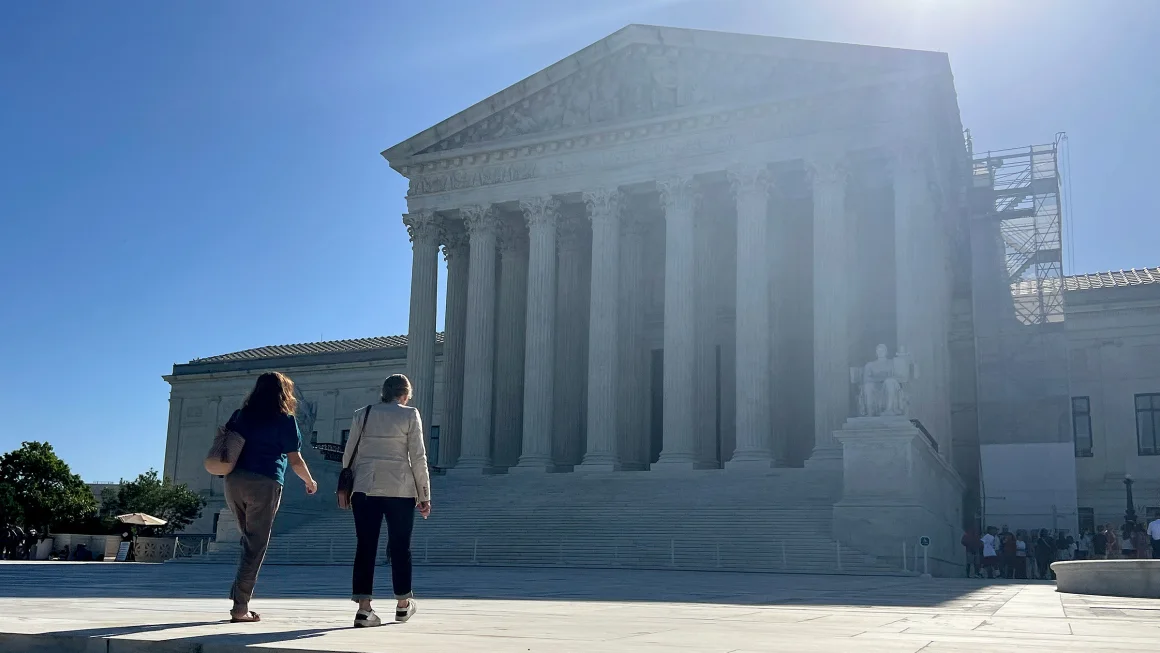CNN — The Supreme Court on Friday struck down a federal ban on bump stocks approved by former President Donald Trump, the high court’s latest stroke limiting the power of federal agencies to act on their own.
Justice Clarence Thomas wrote the opinion for a 6-3 court. The court’s liberal wing, led by Justice Sonia Sotomayor, dissented.
Trump had pushed for the ban in response to a 2017 mass shooting that killed 58 people at an outdoor music festival in Las Vegas. Bump stocks allow a shooter to convert a semi-automatic rifle into a weapon that can fire at a rate of hundreds of rounds a minute.
“A bump stock does not convert a semiautomatic rifle into a machinegun any more than a shooter with a lightning-fast trigger finger does,” Thomas wrote in his opinion. “Even with a bump stock, a semiautomatic rifle will fire only one shot for every ‘function of the trigger.’”
The ban was challenged by a Texas gun store owner, Michael Cargill, who purchased two of the devices in 2018, turned them over to the government after the prohibition was implemented and then promptly sued to get them back. The federal rule made possession of a bump stock a crime punishable by up to 10 years in prison.
Though the case didn’t rely on the Second Amendment, it did put the debate about guns back on the court’s docket in one of the most closely watched controversies this year. In that sense, the decision was the latest from the high court to side with gun rights groups.
Sotomayor reads dissent from the bench
Sotomayor wrote in a scathing dissent joined by the court’s other two liberal justices that the majority’s ruling “will have deadly consequences.”
The decision, she wrote, “hamstrings the Government’s efforts to keep machineguns from gunmen like the Las Vegas shooter.”
In a move that underscored Sotomayor’s discontent with the court’s ruling, the justice took the rare step of reading her dissent from the bench on Friday.
“When I see a bird that walks like a duck, swims like a duck, and quacks like a duck, I call that bird a duck,” Sotomayor wrote in her dissent. “A bump-stock-equipped semiautomatic rifle fires ‘automatically more than one shot, without manual reloading, by a single function of the trigger.’ Because I, like Congress, call that a machinegun, I respectfully dissent.”
From Capone to the Supreme Court
The bump stock challenge was tied indirectly to a gun control law Congress enacted in the 1930s that was intended to target gangsters like Al Capone and John Dillinger. Responding to grisly crimes in which machine guns were used to rob banks or ambush police, lawmakers required owners to register those weapons.
The law was amended several times and, by 1986, it prohibited Americans from transferring or possessing a machine gun altogether in most circumstances. Importantly, the amended law defined “machine gun” as a weapon that fires more than one round with “a single function of the trigger.” What, precisely, that phrase meant was the focus of the appeal.
Both the Trump and Biden administrations, as well as gun control groups, said the way bump stocks work mean they qualify as machine guns. The Bureau of Alcohol, Tobacco, Firearms and Explosives reclassified the devices as machine guns in 2018 and, based on the earlier law, barred people from buying or owning them.
Trump described bump stocks at the time as converting “legal weapons into illegal machines.”
ATF estimated that as many as 520,000 bump stocks were sold between 2010 and 2018. The device replaces a semiautomatic rifle’s regular stock, the part of a gun that rests against the shoulder. It lets shooters use the recoil of the weapon to mimic automatic firing if they hold their trigger finger in place.
Opponents say the ATF overstepped its authority with the reclassification. They noted that the agency under both Democratic and Republican administrations had long said the devices were not covered by the law.
A US District Court in Texas and a panel of three judges on the conservative 5th US Circuit Court of Appeals sided with the Justice Department. But the full 5th Circuit reconsidered the case and issued a fractured opinion last year siding with Cargill.
The court appeared split during oral arguments in late February. Several of the court’s conservatives were concerned, in particular, with the idea that Americans who purchased bump stocks when they were not classified as machine guns could suddenly be prosecuted for a crime they were not aware of.
Justice Brett Kavanaugh worried that the criminalization of the device would “ensnare” Americans.
“Even if you’re not aware of the legal prohibition, you can be convicted,” Kavanaugh told the attorney representing the Biden administration. “That’s going to ensnare a lot of people who are not aware of the legal prohibition.”
Another central theme of the arguments was the question of whether Congress – rather than the ATF – should have approved the ban. It’s an issue that’s emerged as a central theme at the Supreme Court in recent years, with groups challenging financial and environmental regulations in separate cases.
The court, meanwhile, has repeatedly sided with some of the same gun rights groups, including the National Rifle Association, that opposed the bump stock ban. Most recently, the court’s conservative majority invalidated a New York state law that required state residents to have a special need to carry a weapon outside of their homes.
Thomas includes graphics of how bump stocks work
In an opinion that reflected the technical nature of the case and the oral arguments in February, Thomas’ opinion digs deeply into the mechanics of semi-automatic rifles – including with a series of graphics demonstrating what happens when triggers are depressed.
“Firing multiple shots using a semiautomatic rifle with a bump stock requires more than a single function of the trigger,” Thomas wrote, underscoring the idea that the devices are not the same thing as an automatic weapon where a shooter simply holds down a trigger.
“Too much forward pressure and the rifle will not slide back far enough to release and reset the trigger, preventing the rifle from firing another shot. Too little pressure and the trigger will not bump the shooter’s trigger finger with sufficient force to fire another shot,” Thomas wrote. “Without this ongoing manual input, a semiautomatic rifle with a bump stock will not fire multiple shots. Thus, firing multiple shots requires engaging the trigger one time – and then some.”







Richard Benish • Jun 14, 2024 at 6:49 pm
The six who voted to approve bumpstocks are obviously deranged bloodthirsty mother-f***ers.